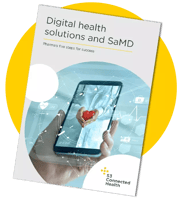Digital health offers many exciting opportunities for pharma, but it’s important to invest in the correct type of solution to deliver value and have the best impact.
Software as a Medical Device (SaMD) is an important distinction for pharma companies to be aware of, since all products classified as SaMD will be digital health solutions, but not all digital health solutions are classified as SaMD.
The International Medical Device Regulators Forum defines SaMD as "software intended to be used for one or more medical purposes that perform these purposes without being part of a hardware medical device." Not included within this definition is software with the intended use of driving a hardware medical device, or those that simply fetch data.
SaMD solutions differ from other digital health solutions in terms of the potential benefits they offer. Simple digital health solutions that deal with non-medical matters like education, engagement, and onboarding target a specific need, but may not offer the results pharma is trying to achieve, as they don't go far enough in terms of aiding or improving patient outcomes.
Making use of digital health solutions that qualify as SaMD, however, offers the chance to differentiate pharma products in the market by going beyond minimal engagement and actively working to manage, treat, and monitor diseases.
What are the benefits of SaMD solutions?
When created and employed effectively, SaMD solutions offer benefits for not just pharma, but all stakeholders, including patients and clinicians.
First and foremost, as SaMD solutions are more likely to be used directly in the treatment of an individual compared with other unclassified digital health applications, they often improve patient outcomes. Using SaMD in a treatment plan can help patients with more holistic condition management by better addressing symptoms and comorbidities.
Secondly, SaMD solutions can allow pharma to further their research and insights on disease trajectory by capturing standardized, real-world data across regions. By combining existing pharmaceutical treatments with digital solutions, they can also differentiate their treatments and stand out in what can be a crowded market.
For clinicians, SaMD can increase confidence and thus boost adoption rates among patients, especially when compared with non-regulated digital health options. In the longer term, this reassurance that solutions are regulated, safe, and appropriate to use can build trust in digitally-delivered treatment elements.
Finally, SaMD can also Improve engagement with payors and healthcare providers by supporting reimbursement with objective real-world data.
It’s important to set out a regulatory roadmap from the beginning
While all pharma companies have the regulatory expertise needed to develop and launch medication, a uniquely different skill set is required when dealing with a digital health product.
Creating SaMD-classified solutions is an intricate process, with a specific regulatory pathway. That makes working to a clear regulatory roadmap essential for ensuring you know exactly what is required, how it needs to be done, and how long it will take to actually roll out your SaMD solution.
While requirements are fairly consistent thanks to standards (such as an ISO 13485
quality management system, IEC 62034 for medical device software development, and ISO 14971 for medical device risk management), getting the process right demands careful planning to ensure all relevant needs are met. This will include market-specific approaches to SaMD classification depending on where you launch (like the FDA’s Clinical Decision Support Software guidance, or the EU MDCG guidance on qualification), as well as classification of software under the MDR.
The concept of intended use, in particular, is extremely important to include in any regulatory roadmap. While it's true that pharma companies also have to define intended use for drugs and medications, doing this for SaMD doesn't quite work in the same way. Intended use for drugs and medications is normally fixed during clinical trials and only changes subject to new trials, whereas digital health solutions are likely to change based on the technology’s evolution, and, crucially, patient and clinician feedback.
Intended use is so important because it’s a clear statement of intent for a given SaMD solution. It determines the regulatory process your product will need to go through, as well as the burden of evidence you’ll be required to submit to substantiate the claims you make about your product. As a result of these, it will also determine what class your device is classified as under FDA and MDR rules, for example.
The intended use is determined by anything the manufacturer communicates about the use of a device, including in instructions for use in promotional or sales materials. To prevent problems further down the line, it’s important to be entirely accurate and consistent around the intended use itself, as well as how you communicate the intended use of your product.
With changes in intended use or classification later on likely to be complex and costly, it’s important to make sure any roadmap you create is comprehensive and takes into account the entire product life cycle.
It’s also important to bear in mind the timeline and cost of various market approval pathways, particularly given overall product development and approval timeline can vary significantly depending on the applicable regulatory classifications.
By collating and sharing this information in the form of a regulatory roadmap, all parties involved in the creation of a digital health solution can get on the same page about what needs to happen, when it needs to happen, and what the results should be at each stage, reducing costly mistakes and misunderstandings that could severely hamper progress.
The below diagram shows what the ideal regulatory roadmap should include:
Don’t go it alone
While creating a SaMD solution will involve a larger regulatory burden – and as such, more development time – there’s no doubt the results can make this a worthwhile endeavor.
The best option for most pharma companies interested in developing SaMD digital health solutions is to partner with a specialist firm that has a proven track record in the area and can offer more than just development capabilities.
At S3 Connected Health, our teams can manage the regulatory burden, provide development capabilities, and help create a digital health strategy that will ensure your solution is successful.
To find out more about how SaMD solutions could help your business – and how to go about creating them – download our latest whitepaper here.
Download the full whitepaper, ‘Digital health solutions and SaMD: Pharma’s five steps for success':



